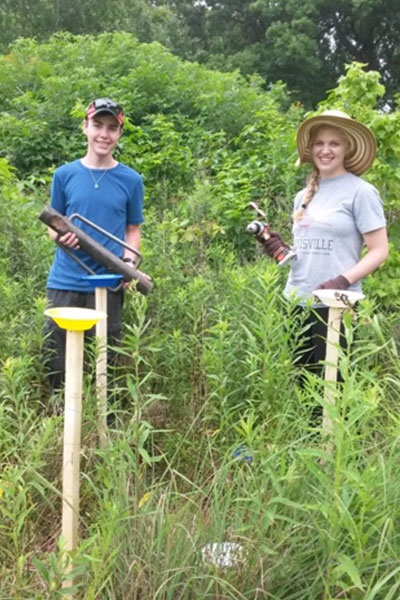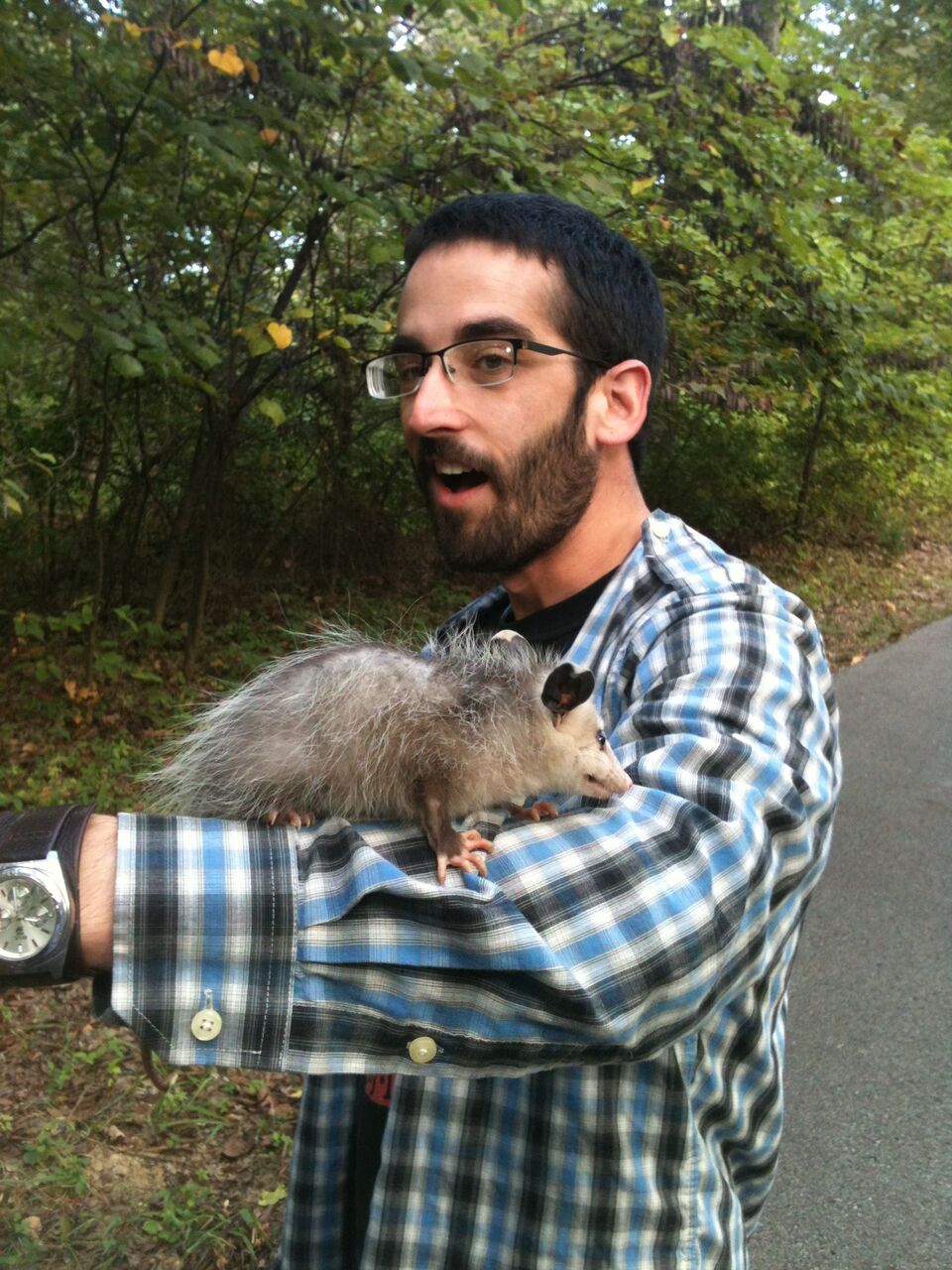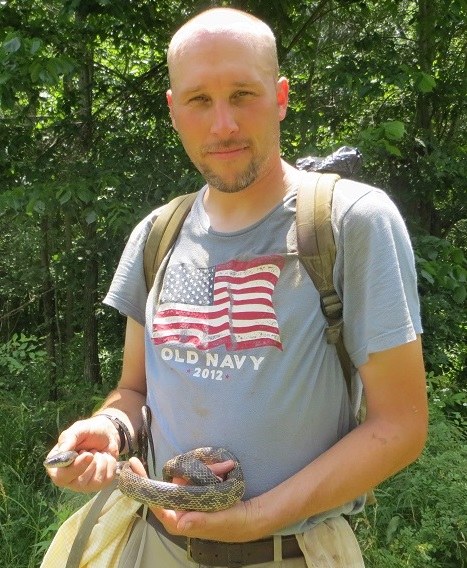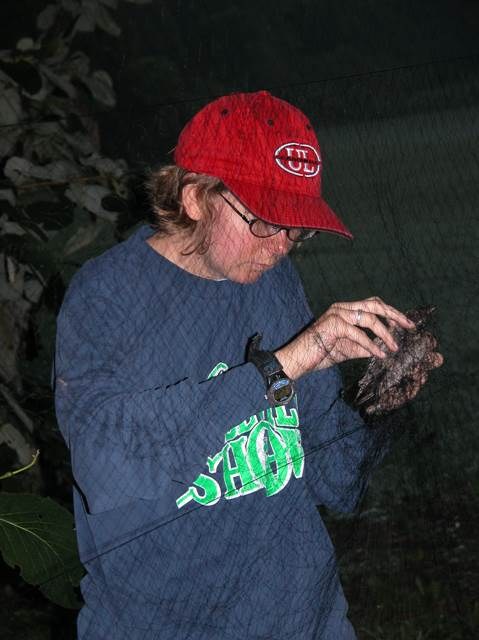Research with Former Graduate Students
 |
Urban gardens and insect conservationWith my graduate student Lindsay Nason, Dr. Margaret Carreiro, and undergraduates Amy Cherry and Jacob Lawson, I investigated whether urban gardens can serve as conservation space for insects. We examined factors that affect the diversity of bees and wasps, butterflies, and flies in native plant gardens in urban and suburban sites in and around Louisville, Kentucky. We also tested how characteristics of gardens affect damage rates on model caterpillars. |
 |
Population Ecology and Individual Movement in the Cave SalamanderMy graduate student Gavin Bradley and I used non-invasive techniques and pattern-matching software to study a local population of cave salamanders, identifying just over 1,000 individuals in 22 months of field work. Our abundance estimates are much higher than previously reported for this species, and we found low capture probabilities and high survival probabilities. These and individual movement data suggest that this species is likely to have a large impact on energy flow in spring caves. |
 |
Resource partitioning in Western Kentucky watersnakesMicah Perkins and I investigated how three closely related watersnakes (Nerodia spp.) partitioned their diets in western Kentucky sloughs where they co-occur and prey on amphibians and fishes. Stable isotope and gut content analyses revealed complex, subtle patterns. Trophic niche width, overlap, and position depended on snake sex, size, and species, but diet also varied seasonally. Each species escaped strong competition from the others in one particular season. Snakes' heads also differed in relative size and shape among species, with the anurophagous plain-bellied watersnake having a longer, more narrow head than either the piscivorous diamondback or the more generalist northern watersnake. In semi-aquatic snakes, slender head shapes can be an adaptation for striking laterally at dense groups of prey. |
 |
Determinants of species richness and conservation status in odonatesVictoria Prescott and I examined patterns of species richness of odonates (dragonflies and damselflies) in urban and rural areas in Kentucky and assessed factors that influenced conservation status in the odonates of North America. In urban areas, species richness was reduced at lentic sites for damselflies but not dragonflies. At lotic sites, species richness did not differ between urban and rural sites for either group. Environmental factors such as nearby development, algal cover, and water temperature had different effects on odonate community composition in lentic versus lotic sites, suggesting different management practices may be required for these ecosystem types. Our literature survey of North American odonates showed that range size and duration of flight season influenced conservation status, but habitat breadth did not. |
 |
Effects of invasive Amur honeysuckle on white-footed miceBill Persons and I examined the impact of the invasive shrub Amur honeysuckle (Lonicera maackii) on white-footed mice (Peromyscus leucopus) in an urban park. Overall plant species richness was greatly reduced under the honeysuckle shrub canopy, but coarse woody debris was more prevalent. We determined that white-footed mice did not alter foraging behavior in response to changes in natural light levels, which we attributed to the greater background illumination of the urban environment. We showed that white-footed mice regularly traverse the honeysuckle canopy, likely for foraging and avoiding predators. We also found that white-footed mice used habitat near human-made paths less often than other habitat, regardless of habitat quality. Our work demonstrates that white-footed mouse behavior differs in urban environments relative to natural environments as a direct response to anthropogenic changes to the environment. |
 |
Evolution and ecology of individual specialization in dietary generalistsCarl Cloyed and I used stable isotopes to investigate the evolution and ecology of individual specialization (IS) in dietary generalists. Our five study species included three frog and two toad species native to Kentucky. These species partitioned their niches by trophic level and by foraging habitat. Within species, however, there was considerable variation in the trophic level at which individuals fed. This IS reduced the number of individuals that overlapped in diet between species, which can increase species coexistence! Interestingly, the ecological factors that influenced IS varied across species, but resource diversity and conspecific density were most frequently the parameters that best explained the degree of IS. |
 |
Territorial defense in cichlid fishesPiyumika Suriyampola and I examined the effects of landmarks on territory size and shape in cichlid fishes in Lake Xíloa, Nicaragua. Territorial residents responded quickly and dramatically to the addition of landmarks. Territories were round without landmarks or with single-point landmarks, but were elongated with linear landmarks. Territory size was reduced in the presence of any landmark, suggesting that a smaller territory with well-defined boundaries has greater benefits than a larger area without clear boundaries. This work has conservation implications because it suggests that wildlife biologists and zoos may be able to increase breeding population size for some species by simple manipulations of visual landmarks. |
 |
Foraging and Alarm Calls in the American RobinNatasha Vanderhoff and I discovered that juvenile American Robins are less adept than adults at foraging for both invertebrates and fruits. Juveniles captured a lower proportion of the invertebrates at which they struck than did adults, and juveniles were twice as likely as adults to fail in an attempt to pick a cherry. These results suggest that contrary to previous assumptions foraging skills may be to some degree learned, even for food items and prey that are relatively easy to acquire. Juveniles were also less nuanced in their responses to robin aerial alarm calls. Although both juveniles and adults foraged less and increased vigilance when they heard alarm calls, only adults were able to distinguish between low and high intensity calls. Juveniles also spent more time alert than adults, suggesting some learning may be involved. |

